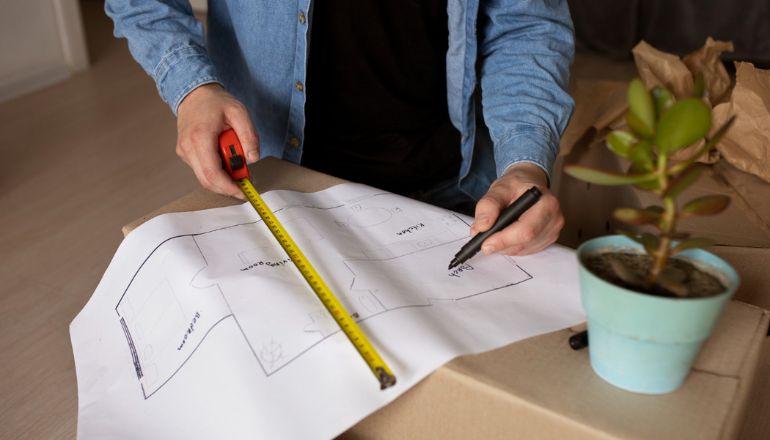How to Measure a Loft Hatch Properly

Thinking about installing a loft ladder or upgrading your existing loft access? The first and most important step is to measure your loft hatch correctly. It’s a small task that makes a big difference. Get it wrong, and you could end up with a ladder that doesn’t fit, unnecessary renovation costs, or even safety issues down the line.
In this guide, we’ll walk you through everything you need to know to measure a loft hatch accurately. From tools you’ll need to common mistakes to avoid, we’ll help you get it right the first time, so your installation is smooth, secure, and stress-free.
Why Accurate Loft Hatch Measurements Matter
Getting the measurements of your loft hatch right is crucial for several reasons. Whether you’re installing a new loft ladder or replacing an existing one, accuracy in these measurements ensures a seamless fit and reduces the chances of complications during installation.
Ensuring a Good Fit for Your Loft Ladder
To ensure that your loft ladder fits properly, you must measure the hatch opening with precision. A too-small opening can make it impossible to install the ladder, while a too-large opening might lead to safety concerns or energy efficiency issues. Proper measurements give you the right size and ensure a smooth operation of the ladder.
Preventing Installation Issues
Inaccurate measurements can lead to significant installation problems. If the hatch is too narrow or irregularly shaped, it may be difficult to position the loft ladder correctly, causing delays or additional costs. Having the right dimensions ahead of time helps avoid these setbacks and guarantees that everything fits as intended, making the installation process faster and more efficient.
Tools You’ll Need to Measure a Loft Hatch
To accurately measure a loft hatch, you’ll need a few essential tools. These tools will help ensure that your measurements are precise and reliable, which is key to a successful loft ladder installation.
- Measuring Tape: A good-quality measuring tape is essential for measuring the dimensions of your loft hatch. Ensure it’s long enough to cover the entire width and length of the hatch and can be easily read for precision.
- Carpenter’s Square: A carpenter’s square helps in determining if the corners of the loft hatch are square (90 degrees). This tool is important for ensuring your measurements are consistent and your hatch is not misshapen, which could affect the fitting of the ladder.
- Spirit Level: A spirit level ensures that your measurements are taken on a perfectly horizontal plane. This tool is especially important when measuring the height and positioning of the hatch in relation to the floor, ensuring the hatch is level.
- Pencil and Paper: While it seems basic, having a pencil and paper on hand for note-taking is essential. You’ll need to jot down the measurements as you take them to ensure you don’t forget any key details during the process.
Step-by-Step: How to Measure Your Loft Hatch
If you’re asking, “How do I measure a loft hatch?”, the process is simpler than you might think. Just follow these clear steps to get accurate results and avoid installation issues later.
Measure the Width and Length
Use a measuring tape to record the internal dimensions of the hatch opening—side to side (width) and front to back (length). Measure from the inside edge of one frame to the inside edge of the opposite frame. Always double-check each measurement to ensure accuracy.
Check the Depth and Clearance Space
Next, measure the depth of the hatch frame—this is the vertical distance from the bottom of the frame to the top where it meets the loft floor. Also, check the clearance space in your loft above the hatch to make sure there’s enough room for the ladder to fold or slide back without obstruction.
Measure the Ceiling Thickness
Finally, measure the thickness of the ceiling around the hatch. This is especially important for choosing a loft ladder that fits securely and finishes neatly against the ceiling surface. Measure from the underside of the ceiling to the floor of the loft.
Common Loft Hatch Sizes Explained
Loft hatches come in a variety of sizes to suit different property types and installation needs. Understanding the typical dimensions can help you determine whether your existing opening is standard or may require customization.
Standard Loft Hatch Dimensions
Most UK homes feature standard loft hatch sizes, which are typically around 562mm x 726mm or 600mm x 800mm. These dimensions are compatible with most ready-made loft ladders and are designed to provide enough room for safe and comfortable access to the loft. If your hatch falls within this range, finding a matching ladder and frame is usually straightforward.
Custom Loft Hatch Options
If your hatch is unusually small, large, or irregularly shaped, you may need a custom-sized loft hatch. These can be tailored to fit the specific dimensions of your opening and may also include additional features such as insulation, draught-proofing, or fire resistance. Custom hatches are ideal for older homes or unique architectural layouts where standard sizes won’t work.
Mistakes to Avoid When Measuring a Loft Hatch
If you’re getting ready to measure a loft hatch, it’s important to avoid common errors that can lead to poor ladder fit, wasted time, or costly modifications. Here are the most frequent mistakes people make and how to steer clear of them.
- Measuring from the wrong points: Always measure the internal dimensions of the hatch opening, not the outer frame or cover. Measuring from the wrong edges can give you misleading results.
- Ignoring ceiling thickness: Failing to include the ceiling thickness in your measurements can affect how well the ladder frame fits, especially if it’s designed to sit flush with the ceiling.
- Forgetting clearance space: Not checking for enough space in the loft to open and fold the ladder can result in major installation problems later.
- Not double-checking measurements: A single incorrect number can lead to ordering the wrong ladder size. Always measure at least twice and record the results clearly.
- Using the wrong tools: A flimsy tape measure or poor lighting can throw off your accuracy. Use the right tools and take your time.
If you’re interested in loft spaces beyond just hatches and ladders, check out our in-depth guide on the Pros and Cons of Living in Loft Apartments; it offers practical insight into what it’s really like to live in a converted loft-style space
What to Do After Measuring: Choosing Your Loft Hatch or Ladder
Once you’ve taken accurate measurements of your loft hatch, the next step is choosing the right hatch or ladder to match your space and usage needs. This decision depends not just on size, but also on the type of access, insulation, material, and frequency of use.
- Select a compatible loft ladder: Based on your hatch size, choose a ladder that fits comfortably within the frame and has enough space to unfold or slide without obstruction. Consider whether you need a folding, telescopic, or sliding model depending on your ceiling height and available loft space.
- Check insulation and sealing features: Many modern loft hatches come with built-in insulation and draught-proof seals, helping to improve your home’s energy efficiency. If your loft is unheated or used for storage, this can make a noticeable difference.
- Choose between standard and bespoke options: If your measurements match standard dimensions, finding a ready-made option is simple. But if you have non-standard sizes, a custom loft hatch or ladder may offer better performance and a cleaner finish.
- Consider your usage style: Will you access your loft regularly or just a few times a year? Daily or frequent use might justify a more durable, comfortable ladder and a hatch with a better finish and easier opening mechanism.
As a final tip, think about the broader design and functionality of your loft space. For example, knowing the difference between a Hard Loft vs Soft Loft can influence your choice of materials, insulation needs, and long-term planning. Take a moment to explore that comparison to make the most informed decision.














